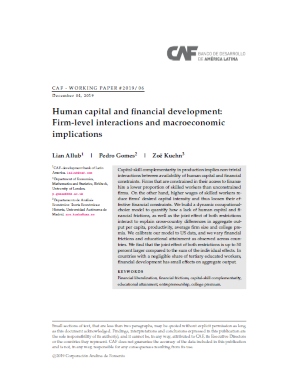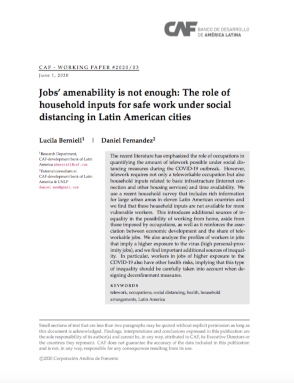Mostrar el registro sencillo del ítem
City Size, Distance and Formal Employment Creation
| dc.contributor.author | O´Clery, Neave | |
| dc.contributor.author | Lora, Eduardo | |
| dc.coverage.spatial | Colombia | en_US |
| dc.date.accessioned | 2016-10-24T22:57:16Z | |
| dc.date.available | 2016-10-24T22:57:16Z | |
| dc.date.issued | 2016-10-09 | |
| dc.identifier.citation | O´Clery, N., & Lora, E. (2016, October 9). City Size, Distance and Formal Employment Creation. CAF – Working paper;N° 2016/09, Caracas: CAF. Retrieved from https://scioteca.caf.com/handle/123456789/959 | en |
| dc.identifier.uri | https://scioteca.caf.com/handle/123456789/959 | |
| dc.description.tableofcontents | Cities thrive through the diversity of their occupants because the availability of complementary skills enables firms in the formal sector to grow, delivering increasingly sophisticated products and services. The appearance of new industries is path dependent in that new economic activities build on existing strengths, leading cities to both diversify and specialize in distinct areas. Hence, the location of necessary capabilities, and in particular the distance between firms and people with the skills they need, is key to the success of urban agglomerations. Using data for Colombia, this paper assesses the extent to which cities benefit from skills and capabilities available in their surrounding catchment areas. Without assuming a priori a definition for cities, we sequentially agglomerate the 96 urban municipalities larger than 50,000 people based on commuting time. We show that a level of agglomeration equivalent to between 45 and 75 minutes of commuting time, corresponding to between 62 and 43 cities, maximizes the impact that the availability of skills has on the ability of agglomerations to generate formal employment. Smaller urban municipalities stand to gain more in the process of agglomeration. A range of policy implications are discussed. | en_US |
| dc.language.iso | en | en_US |
| dc.publisher | CAF | en_US |
| dc.relation.ispartofseries | CAF – Working paper;N° 2016/09 | |
| dc.rights | CC-BY-NC | es_ES |
| dc.rights.uri | http://creativecommons.org/licenses/by-nc/4.0/ | es_ES |
| dc.subject | Ciudades | en_US |
| dc.subject | Educación | en_US |
| dc.subject | Investigación socioeconómica | en_US |
| dc.subject | Sector privado | en_US |
| dc.subject | Trabajo y protección social | en_US |
| dc.title | City Size, Distance and Formal Employment Creation | en_US |
| dc.type | workingPaper | en_US |
| dc.publisher.city | Caracas | en_US |
Ficheros en el ítem
Este ítem aparece en la(s) siguiente(s) colección(ones)
-
6.1 Documentos de trabajo en investigación socioeconómica
En esta colección se encuentran los documentos de trabajo sobre temas económicos y sociales prioritarios para la región.






